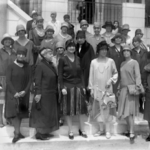 AG About Gender. International Journal of Gender History (Web); Alessia Donà (Trento), Bailey Gerrits (Nova Scotia), Sveva Magaraggia (Milano), and Giovanna Vingelli (Rende)
AG About Gender. International Journal of Gender History (Web); Alessia Donà (Trento), Bailey Gerrits (Nova Scotia), Sveva Magaraggia (Milano), and Giovanna Vingelli (Rende)
Proposals by: 31.10.2024
Scientific literature and the Istanbul Convention attest the fact that gender-based violence (GBV) is a widespread structural phenomenon with deep roots in a shared culture. Therefore, as GBV is the result of an entrenched and stereotyped gendered culture, we consider it as a socio-cultural and structural problem (Manuh & Biney, 2021; Muluneh et al., 2020), rather than the mere result of a „personal or individual disorder“ (Magaraggia, Cherubini 2013).
The editors understand gender-based violence to include any form of violence targeted at an individual or group based on their gender, gender identity, or gender expression. It also refers to categories of violence disproportionately experienced by women (Manuh & Biney, 2021) and gender-queer individuals and groups. It also includes sexual violence, intimate partner violence, online harms, transphobic violence, homophobic violence, etc. The editors assume that men’s violence against women and gender-based violence have a standard matrix structured in the patriarchal system and in the unequal/asymmetrical gender order. Violence, discriminatory behaviour and stigmatisation of differences arenot simply ‚deviant‘ behaviour but contribute to reproducing and supporting the gender order (Wirtz et al., 2020; Ward & Brewer, 2004).
Focusing on the social construction of masculinity – and not just on male „perpetrators“ of violence – allows us to see the transversal nature of different forms of violence, online or offline: violence against women and homophobic or transphobic violence. Gender-based violence can be understood as a means of regulating and reinscribing relationships between men, between women, and between men and women. Confronting men’s violence against women means engaging with a complex discourse about masculinity, men’s roles in society and the patriarchal system. To fully understand the structural and cultural dynamics of gender-based violence, one must consider how systems of inequality and oppression, such as racism, colonialism, disablism, class, etc., interlock to produce and reproduce the conditions for violence. Read more … (PDF in Italian and English)
Source: Gender Campus

 European Journal of Women’s Studies
European Journal of Women’s Studies 
 Remedial Herstory: A Journal of Women’s History for Educator
Remedial Herstory: A Journal of Women’s History for Educator  Wienbibliothek im Rathaus; Katharina Prager
Wienbibliothek im Rathaus; Katharina Prager  Katerina Dalacoura, Vaia V. Geragori, Maria Paitaki, Vasiliki Papadopoulou, and Kostas Tsampouras (Crete), Krassimira Daskalowa and Valentina Mitkova (Sofia), Giorgos Manios (Athens), and Ivana Pantelić (Belgrade)
Katerina Dalacoura, Vaia V. Geragori, Maria Paitaki, Vasiliki Papadopoulou, and Kostas Tsampouras (Crete), Krassimira Daskalowa and Valentina Mitkova (Sofia), Giorgos Manios (Athens), and Ivana Pantelić (Belgrade)  Tijdschrift voor Genderstudies
Tijdschrift voor Genderstudies